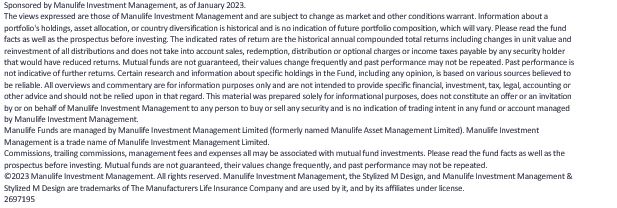
The comeback is on: Why bonds are back
Manulife Investment Management’s co-chief investment strategists on the three phases of fixed income’s return and why shallow recession is firm’s base case
A new year has started, the traditional 60/40 portfolio split is alive and well, and bonds are back. That was the clear message from Kevin Headland, and Macan Nia, co-chief investment strategists at Manulife Investment Management.
After a long period in the unfashionable doldrums, fixed income has come roaring back with some tempting offerings that could be music to the ears of wealth managers. There are three parts to the asset class’s comeback. First, bond yields have normalized and are looking attractive. Indeed, as Macan Nia observed, investment grade yields have not been this high in either Canada or the US since before the financial crisis.
Nia said: “We’ve gone almost 15 years without seeing these types of yields. They haven’t been seeing these type of income opportunities in the last 10 or 15 years, especially as Canadians are getting older.”
He added: “A lot of the issues in the financial markets and for financial advisors was [around] this search for yield and how we drive income for our clients that are retiring. The good news is right now we simply clip the coupon. We believe they are attractive opportunities just in yield.”
The following two phases hinge on economic weakness. In the second phase, recession should start to be priced in and yields on longer duration and higher quality tend to fall. This will contrast with what happened in fixed income last year, when yields rose and prices declined. This year the reverse will be the case and fixed income strategists will be gifted with positive tailwinds should both yields fall and prices rise.
Nia said:
“We should see an increase in fixed-income prices, which drives longer, higher returns, and you want to raise quality and longer duration in that environment, especially looking at Treasury bonds that then do well during recessions.”
The third phase will be when the markets are pricing in the end of the recession and pricing in the riskiest assets at risk of default. Nia believes this will be the point to embrace risk and take advantage of dislocation, finding good businesses that are priced attractively relative to their maturity value.
“The prices of those risky assets tend to go up and high yield perform very well, even as well as equities, often coming out of recession,” Nia said.
In their outlook, the team says the geopolitical and economic outlook is less foggy than it was months ago, a boon for markets that hate uncertainty. There is better visibility for the path of inflation, which is downwards, although the conflict in Ukraine is still a wildcard when it comes to geopolitical risks. No one really has any idea what or how it may play out but the effects on inflation seem to have waned in the second half of last year. Finally, after three long years of its zero-tolerance Covid policy, China is opening up, which should be positive for global growth.
Manulife Investment Management forecasts a shallow recession, which it defines as a drop in GDP of up to – 2 percent, with the odds of a severe recession and of Canada being worse hit than its southern neighbor by an economic downturn being low.
Headland and Nia think the first part of the year will be choppy, with the main challenge this year being earnings in the first couple of quarters. However, that in itself provides an opportunity because not all companies are going to be treated the same, with some companies better able to navigate a high-inflation, high-interest rate environment. They forecast a reacceleration of the global economy in the second half the year as it adapts to higher rates as China reopens. This sets a backdrop for a positive year for equities that was not experienced last year.
Bonds and equities, it’s an old dance and it remains a good one. For quite some time, its demise has been predicted, but the traditional 60/40 portfolio split is alive and well and bonds are, or should be, back in fashion.
Yet, despite the positive outlook for fixed income, many people have fled for the safer shores of Guaranteed Investment Certificates (GICs), a move that Headland and Nia say could be lost opportunity.
They also point out that comparing GICs to fixed income can be misleading because it means comparing the yield but without realizing the optionality of capital gains and price appreciation in fixed income bond funds. Canadian bonds have since their inception outperformed GICs 80% of the time and that outperformance has been greater than 5% nearly 40% of the time.
Kevin Headland noted that there are other advantages to bonds, which do not necessarily expose clients to the reinvestment risk that a GIC does up to three years later.
Headland said: “Even when you look at GIC rates, the long term GIC rates are lower now, in anticipation of what the financial institutions are expecting. So, I think when we talk with clients today, not only are bonds back, but [we’re] not looking at GIC as a replacement for bonds.”
The fog of economic uncertainty is lifting, old tunes are back in fashion and bonds and equities are dancing in step together again. Spring is round the corner.
![]()

